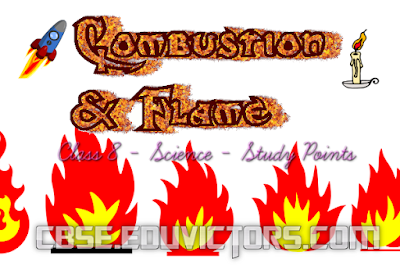CBSE Class 08 Science
Study Points
Chapter 6: Combustion and Flame
⑴ Combustion: The process of burning a substance in the presence of air (oxygen) and undergoes a chemical reaction to produce heat and light.
⑵ The substances which burn in the air are called combustible.
⑶ Oxygen (in air) is essential for combustion.
⑷ During the process of combustion, heat and light are given out.
⑸ Ignition temperature is the lowest temperature at which a combustible substance catches fire.
⑹ Types of combustion: The type of combustion differs depending on the type of fuel. Based on nature and intensity, combustions are classified into three types. They are:
(i) Rapid combustion
(ii) Spontaneous combustion
(iii) Explosion
⑺ The calorific value of a fuel is expressed in kilojoules per kilogram (kJ/kg).
⑻ Flame: It is a zone or burning vapour. The substances which vaporise during burning give flames. Example: Kerosene oil and molten wax.
⑼ Inflammable substances have very low ignition temperature.
⑽ Fire can be controlled by removing one or more requirements essential for producing fire.
⑾ Water is commonly used to control fires.
⑿ Water cannot be used to control fires involving electrical types of equipment or oils.
⒀ There are three different zones of a flame - dark zone, luminous zone and non-luminous zone.
⒁ Fuel is any material that is burned to obtain energy that can be used to heat or move another object.
⒂ A good fuel must:
• Be readily available.
• Be cheap.
• Burn easily at a moderate rate.
• Produce a large amount of heat.
• Not leave behind any undesirable substances.
⒃ Fuels differ in their efficiency and cost.
⒄ Fuel efficiency is expressed in terms of its calorific value which is expressed in units of kilojoule per kg.
⒅ Types of Fuels:
(i) Solid Fuels: Combustible substances which are solid at room temperature. Example: coal, coke, wood, charcoal, etc.
(ii) Liquid fuels: Volatile liquids which produce combustible vapour. Example: Petrol, kerosene, alcohol, diesel, etc.
(iii) Gaseous fuels: Combustible gases or mixture of combustible gases. Example: Natural gas, LPG, biogas, coal gas, etc.
⒆ Effects of Burning of Fuels:
(i) Carbon fuels like wood, coal petroleum release unburnt carbon particles. These are dangerous pollutants causing respiratory diseases, such as asthma.
(ii) Incomplete combustion of carbon fuels gives carbon monoxide which is a poisonous gas.
(iii) Increased concentration of carbon dioxide in the air is believed to cause global warming.
(iv) Oxides of Sulphur and nitrogen dissolve in rainwater and form acids. Such rain is called acid rain. It is very harmful to crops, buildings and soil.
⒇ Unburnt carbon particles in air are dangerous pollutants causing respiratory problems.
(21) Incomplete combustion of a fuel gives poisonous carbon monoxide gas.
(22) Increased percentage of carbon dioxide in the air has been linked to global warming.
(23) Oxides of sulphur and nitrogen produced by the burning of coal, diesel and petrol cause acid rain which is harmful to crops, buildings and soil.
(24) By choosing the right fuel, we can reduce the negative impact on the environment. A great example of this is cars, buses and auto rickshaws that run on Compressed Natural Gas, or CNG, instead of petrol. CNG is a much cleaner and cheaper fuel.
☛See also:
Ch 6 - Combustion & Flame (Q & A)
Ch6 - Combustion & Flame (MCQs)
Ch 6 - Play Game to label zones of a flame
Ch 6 - Combustion and Flame (Study Points)

No comments:
Post a Comment
We love to hear your thoughts about this post!
Note: only a member of this blog may post a comment.